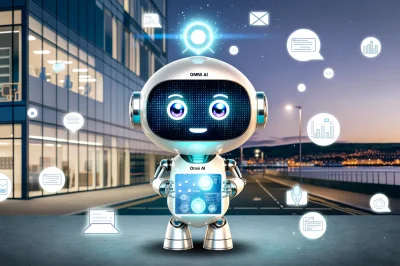The Power of AI Automation in Marketing

Imagine being able to predict your customer’s next move before they even know it themselves. That’s the power of AI automation in marketing. In today’s competitive landscape, staying one step ahead could be the difference between thriving and just surviving. This section will guide you through how AI automation can help you effectively reach and engage your audience with personalised marketing strategies.
Using AI to Understand Your Audience
AI is transforming the way businesses understand their customers, providing insights that allow for tailored marketing strategies. By harnessing robust data analytics tools, companies can decipher consumer behaviour patterns, leading to greater engagement and efficiency in marketing efforts. Let’s explore how AI facilitates this understanding through advanced technologies and useful tools.
Core AI Technologies Driving Consumer Behaviour Analysis
AI-powered tools harness technologies like machine learning, natural language processing (NLP), and data mining to analyse vast amounts of consumer data. These methods enable businesses to:
- Predict behaviour: Forecast customer actions based on historical data.
- Analyse sentiment: Understand customer emotions through feedback and social media.
- Conduct real-time analysis: Monitor interactions for instant trend detection.
Key AI Tools for Marketing Insights
| Tool | Primary Use Cases |
|---|---|
| Insight7 | Accelerates analysis of customer feedback to identify patterns |
| Qualtrics | Enhances survey analysis using AI for insights into preferences |
| Brandwatch | Provides social listening and sentiment analysis |
| Xineoh | Predicts consumer behaviour and recommends personalised products |
| Quantilope | Automates survey design and predictive trend forecasting |
| Hotjar | Analyses user behaviour through heatmaps and session recordings |
Applications in Marketing Strategy
- Personalisation: AI tools analyse purchase histories to tailor recommendations, enhancing customer experience.
- Trend Prediction: Tools like Xineoh identify emerging market trends for timely marketing strategies.
- Competitor Intelligence: Platforms like Browse AI automate the gathering of competitor data for a strategic advantage.
- Customer Segmentation: Machine learning algorithms segment audiences based on behavioural data, refining marketing efforts.
Benefits for Businesses
- Faster insights: Automated analysis streamlines decision-making.
- Enhanced pattern detection: Identifies significant trends often overlooked by manual methods.
- Scalable personalisation: Allows marketers to target segments effectively.
- Cost efficiency: Reduces data analysis costs through automation.
Incorporating AI into marketing strategies not only enhances the understanding of consumer behaviour but also facilitates the shift from reactive to proactive marketing approaches, fostering long-term customer relationships.
Personalisation with AI
AI has transformed marketing through automation-driven personalisation, creating bespoke experiences for various customer segments effortlessly. By leveraging advanced technologies, businesses can deliver more relevant content and engage customers on a deeper level, leading to increased loyalty and sales.
Automated Audience Segmentation
AI utilises machine learning algorithms to automatically segment customer data based on behavioural patterns, demographics, and preferences. This allows brands to tailor their messaging precisely. For instance, companies can adjust marketing campaigns in real-time, enabling them to stay responsive to consumer trends and preferences. Successful brands like Coca-Cola and Heinz have effectively used AI-powered tools to create personalised marketing messages. Coca-Cola’s collaborative generative AI campaigns merge art and branding, crafting unique experiences for audiences.
Dynamic Content Personalisation
With AI, businesses can dynamically alter content or messaging to meet the unique needs of different segments. Platforms like Adobe’s Marketo use predictive analytics to adapt marketing content, ensuring that the right message reaches the right audience at the right time. For instance, Jopwell’s email campaigns, powered by AI, have achieved impressive open rates of 30% by sending highly relevant content tailored to specific audience segments.
Successful Campaigns
Examples of successful AI-driven campaigns abound. Virgin Voyages recently launched a campaign that used AI to send personalised cruise invitations, garnering high engagement through a blend of celebrity and customer interaction. Similarly, Cadbury utilised AI to generate culturally relevant advertisements tailored to local contexts, demonstrating how personalisation can enhance cultural resonance and brand loyalty.
With AI enhancing automation and personalisation, businesses can not only save time but also create marketing strategies that resonate powerfully with customers. As we transition into exploring further AI applications in marketing, the focus will shift to actionable insights derived from extensive data analysis.
Data-Driven Decision Making
Artificial Intelligence (AI) is revolutionising how businesses extract actionable insights from vast reservoirs of data. For small business owners in Swansea, harnessing AI not only streamlines operations but also transforms decision-making processes. By leveraging data-driven insights, businesses can identify trends, optimise marketing strategies, and ultimately drive sales.
The Power of Data-Driven Insights
AI algorithms analyse an immense amount of data—far beyond human capability—transforming raw numbers into meaningful insights:
- Predictive Analytics: AI can predict customer behaviour, enabling businesses to tailor their offerings proactively.
- Customer Segmentation: Data-driven segmentation allows companies to create tailored marketing strategies that resonate with specific demographics.
- Real-Time Insights: With AI, business owners can receive real-time feedback on campaign performance, allowing for swift adjustments.
Case Study: Financial Services and Retail Transformation
A notable UK case involves a financial services firm that integrated AI-driven predictive analytics into its marketing strategy. By optimising its campaign budgets based on AI insights, the firm achieved a staggering 40% increase in leads and reduced acquisition costs by 30%. Similarly, a retail brand utilised AI to develop personalised email marketing campaigns. The result? A 35% lift in open rates and a 20% increase in sales, demonstrating how AI can turn data investments into direct revenue growth.
AI’s role in offering these actionable insights means that Swansea’s small businesses can refine their marketing approaches, enabling them to compete more effectively in a crowded marketplace. As we delve deeper into practical implementation, explore how these insights can be integrated into your marketing strategy to yield tangible results.
Implementing AI Tactics
To thrive in today’s digital landscape, adopting AI automation in marketing is no longer a luxury but a necessity for small businesses, especially in Swansea. Here’s a practical step-by-step guide to getting started, including common challenges and effective solutions.
1. Identify High-Impact Marketing Tasks for Automation
- What to Do:
- Audit your marketing workflows to pinpoint repetitive tasks such as social media posting, email campaigns, or customer segmentation.
- Prioritise tasks that consume excessive time or resources, like lead scoring or data analysis.
- Challenge: Recognising where AI can add value without overcomplication.
- Solution: Utilise tools like Jasper for content drafting and HubSpot for email automation to streamline high-volume tasks, allowing you to focus on strategic initiatives.
2. Select AI Tools Aligned with Your Budget
- What to Do:
- Explore Free/Cost-Effective Tools:
- ChatGPT / Jasper for content generation
- Grammarly for text optimisation
- BuzzSumo for content analysis
- Consider mid-tier solutions like Mailchimp AI for automated emails or Google Analytics 4 for insights.
- Challenge: Initial costs or complexity in tool integration.
- Solution: Start with trial versions or AI-as-a-Service (AIaaS) platforms to minimise investment risk and complexity.
3. Integrate AI into Existing Marketing Workflows
- Process:
- Audit Content Types: Map existing content to identify bottlenecks.
- Design AI-enhanced workflows: For instance, use AI for idea generation, research, and draft writing, with human editing for quality.
- Set quality controls to ensure high standards for AI-generated content.
- Challenge: Team resistance to new technology.
- Solution: Create standard operating procedures (SOPs) and designate an “AI champion” who can facilitate the transition and encourage adoption.
4. Train Teams and Address Skill Gaps
- Actions:
- Participate in workshops or online courses to build foundational AI knowledge.
- Collaborate with AI consultancies for tailored training programmes.
- Challenge: Shortage of AI/ML talent.
- Solution: Upskill existing personnel through affordable courses or implement AI tools that require minimal technical expertise.
5. Ensure GDPR Compliance and Data Security
- Urgent Steps:
- Implement GDPR-compliant tools for data collection.
- Encrypt sensitive data and limit access.
- Regularly conduct audits to ensure compliance with regulations.
- Challenge: Risk of non-compliance fines.
- Solution: Utilise explainable AI models and maintain transparent decision-making processes to meet legal standards.
6. Monitor ROI and Optimise Over Time
- Metrics to Track:
- Cost Savings: Calculate time saved on repetitive tasks.
- Engagement Metrics: Measure click-through rates of AI-optimised content.
- Lead Quality: Compare AI-generated leads directly against those sourced manually.
- Challenge: Lack of clear success criteria.
- Solution: Align AI metrics with overall business objectives, such as aiming for a 20% increase in conversion rates.
Common Challenges and Solutions
| Challenge | Solution |
|---|---|
| High Upfront Costs | Utilise R&D Tax Credits for tech adoption. |
| Talent Shortages | Partner with AIaaS providers for expert support. |
| Scalability Issues | Leverage cloud-based platforms for flexible scaling. |
By targeting straightforward tasks such as chatbots or content optimisation, Swansea SMEs can not only improve their operational efficiency but also drive significant growth through AI marketing automation.
Ready to explore these AI tools further? Our next section will cover specific AI solutions tailored to enhance customer engagement.
Sources
- Insight7 – Best AI Tools for Analyzing Customer Behaviour
- Graphite Note – AI for Customer Behavior Analysis: Revolutionizing Customer Insights
- Remesh – How AI is Changing Consumer Insights
- Rapid Innovation – How AI Predicts Customer Trends and Behavior
- GWI – AI Market Research Tools
- AI Elevation – AI Implementation for Small Businesses
- NCS London – AI Implementation Challenges for SMBs
- Phillip Hughes – AI Content Creation Small Business Guide
- Grow Partnership – How Small Businesses Can Use AI
- Marketing Originals – AI Integration for Small Businesses
- Affordable Marketing Solutions: The Swansea Small Business Growth Plan Under £500/Month – 15 May 2025
- AI in Accounting Marketing: Leveraging Technology for Client Acquisition – 15 May 2025
- The Essential Legal Content Management System: Organize Your Thought Leadership for Maximum Impact – 14 May 2025






